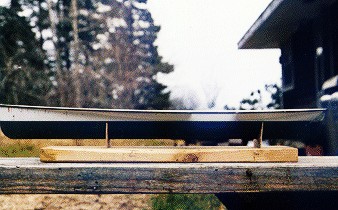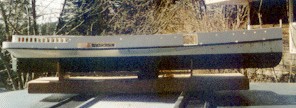MODEL OF THE J T MORSE



 I was commissioned to build this model of the steamer J T Morse.
The model is constructed entirely of bass wood, with brass and britannia pewter fittings.
I was commissioned to build this model of the steamer J T Morse.
The model is constructed entirely of bass wood, with brass and britannia pewter fittings.I drew the ship in 1/96th scale to ensure correct proportion, window placement, etc. Construction began with a half model made from dimensions given in Mr. John M. Richardson's book, "Steamboat Lore of the Penobscot", and with the aid of photographs. Twenty seven frames were made from this half model and attached to a full profile keel. The frame was then planked with 1/32" basswood planks. The stem and stern frames are solid basswood blocks to facilitate the ease of planking. The inside of the hull was then coated with epoxy resin for rigidity and water-tightness. You may ask why watertightness. The answer is, because personally I think a model should float! Also, I like to photograph my boats in their natural element.
 The hull was then painted and ballasted with lead to bring it near it's designed waterline. The paddle wheels were then constructed and installed along with the beam engine which I built from basswood, using detailed drawings of a typical beam engine that I found in the library.
I then built the superstructure using 1/32" basswood.
The hull was then painted and ballasted with lead to bring it near it's designed waterline. The paddle wheels were then constructed and installed along with the beam engine which I built from basswood, using detailed drawings of a typical beam engine that I found in the library.
I then built the superstructure using 1/32" basswood.
The smokestack is constructed of brass shim stock and the whistle is turned from brass rod.
I am in the process of detailing the model at this point. Carved lifeboats are now installed, along with their davits and blocks. (See photographs here).
What remains to be done:
Most rigging, fences around saloon and hurricane deck, lettering, human figures, various deck furniture.
 I plan to install the model in a glass case modeled after one I saw at the Mystic Seaport Museum. This case suspended the model about 6" above the bottom of the case on a transparent water simulation. I haven't worked out the construction details yet, but it will probably involve plexiglass and casting resin.
I plan to install the model in a glass case modeled after one I saw at the Mystic Seaport Museum. This case suspended the model about 6" above the bottom of the case on a transparent water simulation. I haven't worked out the construction details yet, but it will probably involve plexiglass and casting resin.

A history of the Steamer J T MORSE